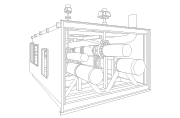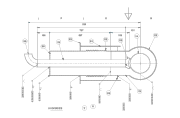The Air Separation Unit (ASU) is a key technology in many industries.
As demand for industrial gasses continues to rise, ASUs provide an efficient and reliable way to produce oxygen, nitrogen, and argon at the required purity levels. Thanks to cryogenic air separation, these gases can be produced in large volumes at lower costs compared to other methods.
But what exactly is an Air Separation Unit, how does it work and what are its key applications? Here’s a guide to the ASU, written from our experience in cryogenic engineering and design and manufacture of these structures.
What is an Air Separation Unit?
An Air Separation Unit is an industrial plant that separates atmospheric air into its main components: oxygen, nitrogen, and sometimes argon and rare gases.
Typical ASU components include:
- Air compressors
- Purification systems
- Heat exchangers
- Cryogenic cooling equipment
- Distillation columns
These parts work together to ensure gases are produced at high purity levels.
Keep reading: Applied cryogenic technologies in the industry
How does an Air Separation Unit work?
The most common method used is cryogenic distillation of air. The principle is simple: air is cooled to very low temperatures so it can be liquefied and then separated based on boiling points.
Step-by-step ASU process
- Compression: in this stage, atmospheric air is drawn into the ASU and passed through a series of compressors to increase its pressure. The purpose is to make the subsequent cooling and separation processes more efficient, with typical pressure ranges going between 5 and 10 bar gauge.
- Purification: before further processing, the compressed air is typically purified to remove impurities (including moisture, carbon dioxide, or trace contaminants). This step ensures that the separated gasses are of high purity and avoids issues such as the freezing or plugging of the cryogenic equipment.
- Cooling: the now purified, compressed air is cooled down to cryogenic temperatures using a series of heat exchangers and refrigeration cycles. This results in liquefying the air, as cryogenic distillation relies on the differences in boiling points of the various components.
- Separation: the now cold, liquefied air is fed into a distillation column (or a series of distillation columns), so that the air is separated into its primary components based on differences in boiling points:
- Nitrogen has a lower boiling point (-196°C or -321°F)
- Oxygen boils at -183°C (-297°F)
- Argon, if being separated, has an even lower boiling point (-186°C or -303°F).

As the air ascends the column, it is gradually warmed, and different components evaporate at their respective boiling points. For instance, oxygen-rich vapor rises to the top of the column, while nitrogen-rich liquid collects at the bottom. The argon, if present, is usually extracted as a side product at an intermediate point in the column.
- Collection, storage and delivery: the separated gasses are collected and sent to storage tanks, either pressurized tanks or cryogenic tanks. From there, the gasses can then be distributed and supplied to various industries and applications, depending on their purity requirements.
This fractional distillation process is what makes ASUs so efficient for industrial gas production.
Applications of an ASU
Air Separation Units play a role in many industries:
- Healthcare: the use of oxygen and other technical gasses in the healthcare industry can benefit from an ASU
- Industrial processes: the Air Separation Unit is part of the applied cryogenic technologies in the industry for processes such as metal fabrication, chemical production, and wastewater treatment. It’s also involved in generating high-purity gasses for the semiconductor industry for processes like wafer manufacturing and device fabrication.
- Food and beverage: nitrogen is used as part of what are known as the ‘food gasses’, used in the food and beverage industry for packaging and preserving products.
- Energy production: an ASU can provide high-purity oxygen for use in combustion processes in power plants and steel mills.
You must be interested: Cryogenic industrial solutions that every cryogenic company should offer
Cryospain, experts in ASU design and engineering
At Cryospain, we combine two decades of expertise in cryogenic engineering with cutting-edge technology. We design, manufacture, and implement customized ASU projects, covering the entire lifecycle from planning to commissioning.
Our strengths include:
- Full assembly, testing (FAT), and installation of ASU components.
- End-to-end engineering services (design, drawings, 3D modeling, calculations).
- Manufacturing in two large-scale workshops with strict quality standards.

Finally, we present an outstanding production capacity, with two large-scale workshops and two industrial hubs which sum up a combined 2600m2 dedicated to realizing our clients’ projects while guaranteeing the highest quality standards.
Cryospain success stories
Our success stories include:
- The provision of components for a containerized ASU project, a kind of prefabricated or modular ASU that facilitates transport, assembly, commissioning and installation. The result was a containerized ASU plant that presents cutting-edge rapid cooling and refrigeration technology, guaranteeing its cost-effectiveness.
- An integral cryogenic pipe-in-pipe system for a new Air Separation Unit in Ostrava (Czech Republic) for a major steel production company.
- Two cryogenic piping projects in Poland and Russia, involving vacuum-insulated piping (VIP) for an Air separation unit (ASU) as part of a modern steel mill. The projects prioritized reducing its environmental impact in the area, so that it produces up to three times fewer emissions than a traditional mill.
Looking for a reliable, state-of-the-art and personalized Air Separation Unit project? Look no further. At Cryospain, we adapt to each project’s needs all while ensuring the highest manufacturing quality and taking into account cost-effectiveness. Get in touch with us and speak to our team about how we can help you.










 Contacte-nos
Contacte-nos